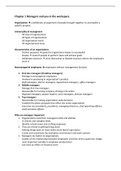Chapter 1 Managers and you in the workspace
Organization → a deliberate arrangement of people brought together to accomplish a
specific purpose
Universality of managment
- All sizes of organizations
- All types of organizations
- All organization levels
- All organizational areas
Characteristics of an organization:
- Distinct purposes → goals the organization hopes to accomplish
- People → need of people to perform tasks and achieve goals
- Deliberate structure → strict (hierarchy) or flexible structure where the employees
work in
Nonmanagerial employees → employees without management function
1. First line managers (frontline managers)
- Manage nonmanagerial employees
- Involved in producing in organization’s product
- Shift managers, district managers, department managers, office managers
2. Middle managers
- Manage first-line managers
- Responsible for turning company strategy into action
- Regional managers, project leaders, store managers, division managers
3. Top managers
- Responsible for making organization wide decisions
- Establish the plans and goals that effect the entire organization
- Executive vice presidents, presidents, managing directors, chief operating officers,
chief executive officers
Why are managers important
1. Organizations need their managerial skills and abilities
- In chaotic and complex times
- Identify critical issues and crafting responses
2. They are critical to getting things done
- Getting things back on track (when work doesn’t get done)
- Create and coordinate the workplace environment and work systems
3. Managers do matter to organizations
- Quality of the relationship between employees and their direct supervisor (single
most important variable in employee productivity)
- Can have an effect on financial score






